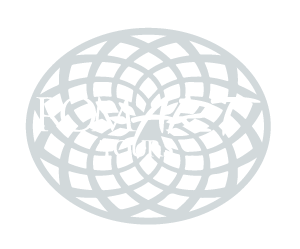Timelines are lifelines!
It’s not easy to orientate in a three-millennia-old city, where new structures originated on top of the older ones, buildings were added to, or simply changed their function… So let’s take a quick look at the different layers this city is made of, much like a delicious lasagna.
For each period, I’ve listed the most significant sights to visit. Ready? Let’s go!
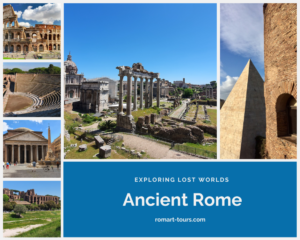
3000 B.C.E. – 476 C.E. Ancient Rome: conquests, generals, emperors, architects, engineers and jurists
This is probably what comes to mind immediately, when you think of Rome: the power and glory of the Roman Empire, and the amazing ruins all over the Eternal City.
In the city centre…
- the Colosseum, the Roman Forum and the Imperial Palaces on Palatine Hill;
- the Imperial Forums and Trajan’s Market;
- Trajan’s Column and the Column of Marcus Aurelius;
- the Theatre of Marcellus;
- the Circus Maximus;
- the Velabrum area, with the wonderful temples of Hercules and Portunus;
- the Baths of Caracalla;
- Nero’s Domus Aurea;
- the Pantheon;
- the Ara Pacis;
- and the main archeological museums (Capitoline Museums, Centrale Montemartini, Palazzo Massimo, Palazzo Altemps, Baths of Diocletian).
…and outside the city walls:
- the Aurelian Walls with the impressive city gates;
- the Pyramid;
- the Catacombs;
- the Appian Way, and the Roman aqueducts;
- the ancient harbour of Ostia Antica;
- Hadrian’s Villa in Tivoli.
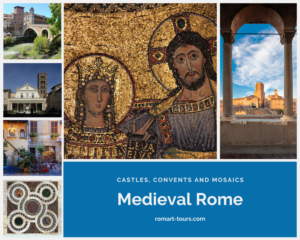
476 – 1492 Medieval Rome: castles, convents, churches, towers and mosaics
The Middle-ages (aka the Dark Ages) live on in the many towers and fortresses that you can notice around Rome, and can be approached best by visiting some of the most fascinating churches dotting the city:
- intriguing San Clemente with its underground excavations;
- fortress-like SS. Quattro Coronati including the convent where some cloistered nuns still live;
- the cathedral of Rome: S. Giovanni in Laterano, with the Holy Steps leading up to the Sancta Sanctorum chapel;
- Santa Maria Maggiore with its iconic bell-tower and its sparkling mosaics;
- S. Prassede and S. Pudenziana, hidden away in small alleys and boasting some dazzling mosaics;
- the Tiberina Island and the whole district of Trastevere and its churches: S.Cecilia and S. Maria in Trastevere;
- S. Sabina on top of the Aventine Hill, and S. Maria in Cosmedin and S. Giorgio in Velabro at the foot of the hill.
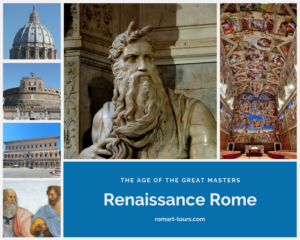
1492 – ca. 1600 Renaissance Rome: warrior popes and great masters of art
The Renaissance can be seen as the age of the great masters, such as Michelangelo and Raphael:
- Villa Farnesina, with Raphael’s vibrant frescoes;
- Michelangelo’s statue of Moses in the church San Pietro in Vincoli;
- Piazza del Campidoglio, the main square on top of Capitol Hill, with the City Hall and the impressive buildings housing the Capitoline Museums – and the famous star design created by Michelangelo to decorate the floor;
- Piazza Farnese with Palazzo Farnese, where you can see Michelangelo’s work as an architect;
- lively Campo de’ Fiori and its market, and the picturesque alleys around it;
- the Papal fortress Castel Sant’Angelo, with its grand frescoed rooms and beautiful panoramic terrace;
- last, but not least, the Vatican Palaces now housing the famed Museums, and the Sistine Chapel.
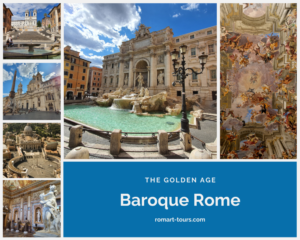
1600 – ca. 1750 Baroque Rome: flamboyant beauty
This can be truly considered to be the city’s second golden age, since the Baroque style has left the biggest imprint on the city.
- St. Peter’s basilica and the breathtaking square designed by Bernini;
- Piazza Navona with Bernini’s Fountain of the Four Rivers;
- the churches of S. Agnese, S. Ivo, S. Ignazio, Il Gesù, all full of paintings, gilded stucco-work and marvelous statues;
- Caravaggio’s masterpieces in the churches of S. Luigi, S. Agostino and S. Maria del Popolo;
- the magnificent Trevi Fountain, the iconic Spanish Steps, grand Piazza del Popolo;
- the Quirinal Palace;
- Bernini’s and Borromini’s rivalry marking the golden mile of the Baroque, where you find the great works of the two masters in the churches of S. Andrea, S. Carlino and S. Maria della Vittoria;
- Piazza Barberini and the picture gallery in Palazzo Barberini, especially the gorgeous ceiling painted by Pietro da Cortona in the great hall of the palace;
- the splendor of the aristocratic palaces, sometimes still owned by the noble families of bygone days, with their dazzling art collections: Palazzo Colonna, Palazzo Doria Pamphili, the Corsini and the Spada Galleries;
- the Borghese Gallery housing masterpieces by both Caravaggio and Bernini.
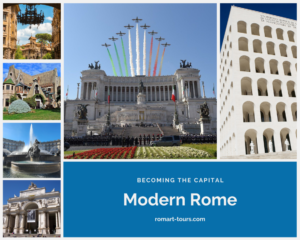
ca. 1800-1945 Modern Rome: becoming the capital
Rome became the capital of Italy in 1871. That brought about some big changes in the urban landscape, with new neighborhoods originating, and wider streets being build in the old section of town. It also paved the way to some surprising experiments in town planning and architectural masterpieces:
- the old Termini train station;
- Piazza Vittorio, with the nice gardens in the centre of the square, originally a neighborhood built to accomodate the many civil servants who came to work in the newly established capital;
- Piazza della Repubblica with the Fountain of the Naiads;
- the Viktor-Emanuel Monument on Piazza Venezia;
- Villa Torlonia, a sprawling country estate build for the richest family of the Italian kingdom, and later home of the fascist leader and prime minister Benito Mussolini;
- the dreamy Coppedè district, to admire some amazing art nouveau buildings;
- the National Gallery of Modern Art (aka GNAM) and the Palazzo delle Esposizioni on Via Nazionale, built for the Expo held in 1911;
- the Garbatella neighborhood, to see a perfect example of an English garden-city reinterpreted by Italian architects;
- the EUR district, with its unexpected rationalist architecture.
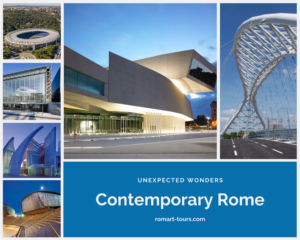
1945-present Contemporary Rome: unexpected wonders
Rome rarely gets associated with contemporary architecture, but in recent years the city has been enriched by a number of interesting buildings by well-known architects:
- the new Termini and Tiburtina train stations
- the Olympic Stadium
- the convention centre “Nuvola” by Massimiliano Fuksas;
- Renzo Piano’s Auditorium;
- the Maxxi Museum for XXI century art, by star-architect Zaha Hadid;
- the new bridges Ponte della Musica and Ponte Settimia Spizzichino;
- the churches built for the Holy Year in 2000, such as Le Vele, the Sails, by US architect Richard Meier, in the Tor Tre Teste neighborhood;
- the flourishing of street art, for example in the Tor Marancia and Ostiense districts.
